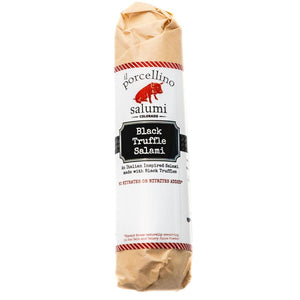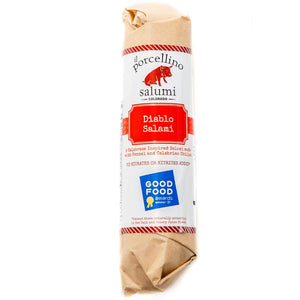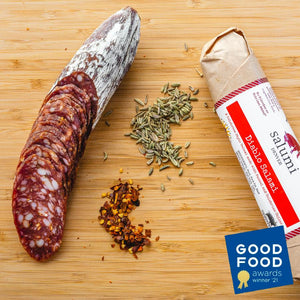You have questions about cured meat, and we have answers. il porcellino salumi has been curing meat since 2015, and I’ve been curing meat with a focus since 2010. It’s safe to say we have a few years of experience under our belt and a few award-winning cured meat products to back it up. Shameful plug, I know.
Seriously, what is cured meat?
The National Center for Home Food Preservation states that curing meat is the process of using salt, sugar, nitrite, and/or nitrate to preserve the meat itself and its flavor and color. However, we don’t fully buy that. Or we should say that we follow natural curing processes that use a natural form of nitrates in sea salt and celery powder.
Cured vs. Uncured Meat. What’s the difference?
Ultimately, they’re the same thing, but it’s all in the process of getting to the end product. Cured meats use human-made sodium nitrite, while uncured meat uses natural curing products, like celery powder.
At this time, the USDA defines cured meat based on using sodium or potassium salts of nitrate and nitrite, which are regulated, to get the end product. Basically, “cured meat” includes the addition of sodium nitrite, sodium nitrate, potassium nitrite, or potassium nitrate. Under this process, the most common curing ingredient is sodium nitrite.
As noted, uncured meats are cured but are labeled uncured because they use a product with naturally occurring nitrates like celery powder. If you cure your product without one of the USDA-recognized curing agents noted above, you’re required to list the product as “uncured” followed by “no nitrate or nitrite added except those naturally found in (added ingredients)” on the label.

Nitrates naturally occur in celery powder, and when the nitrates combine with certain bacteria, they reduce to nitrites which are necessary to create cured meat.
We make our salami and cured meat products with celery powder and sea salt. We prefer the natural ingredients and process to make our products instead of using pure sodium nitrite.
Is cured meat raw?
Technically, yes, because the meat is not cooked, which is defined by heating the product. The process of dry curing the meat removes moisture and other elements that meat spoiling bacteria need to survive.

Our salami, pictured above, dries in our climate-controlled drying rooms. In a sense, the curing process cooks the meat differently but still makes it edible.
How long does cured meat last?
The shelf life of cured meat is variable, but in general, they last quite a while, like months to years. Different types of cured meat will have a longer shelf life, and it will also vary depending on the producer and their methods.
We always recommend keeping the cured meat you purchase in the fridge or follow the package instructions. We feel like our salami stays fresh for 9 - 12 months, and we recommend keeping it wrapped in the paper packaging and stored in your fridge crisper drawer.
Why does cured meat last so long?
Cured meat lasts so long because it’s dried. It’s all about the moisture content. The use of salt and other curing agents draws moisture out of the meat, and without moisture, the bacteria that spoil meat can’t survive.
Dry curing sounds simple, but it’s a very balanced process that requires the correct amounts of each ingredient. If the drying process happens too slow, bacteria can grow, and if it happens too fast, the surface of the meat can get funky.
Is cured meat unhealthy?
We get this question a lot, and the overall answer is no, but we can’t speak for everyone’s dietary needs. There isn’t anything outright unhealthy about cured meat, especially our cured meats, but each person is different. If you have concerns, I recommend speaking with your doctor, who knows your health history.
What’s the difference between cured meat and charcuterie?
Well, charcuterie is a French term for a type of cooking that focuses on prepared meat products primarily from pork. It developed as a way to preserve the meat before refrigeration came into the mix. This includes products like bacon, ham, sausage, pâté, and much more. Technically your charcuterie board is a charcuterie, cheese, and whatever else you put on it, board.
So, they’re not different. The term charcuterie includes cured meat in its definition.

Obviously, the term charcuterie has taken on a much larger definition over the years. It’s become an umbrella term because when most folks hear “charcuterie board,” they assume it includes meat, cheese, pickled vegetables, fruits, crackers, and anything else on the board. Personally, it doesn’t matter to me, and I love charcuterie boards, but now you have a random piece of knowledge you can drop on your friends and family.

I hope this clears up some of the cured meat confusion but send us any questions you have and we’ll try to answer them. If you’re interested in trying some of our meats, all our salami flavors are available for nationwide shipping from our online store. If you’re in Denver, swing by the store to try our other products and chat meats!







